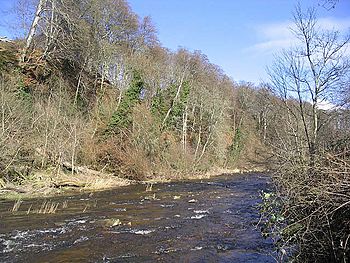Jed Water facts for kids
Quick facts for kids Jed Water |
|
|---|---|

The Jed Water near Jedburgh
|
|
| Lua error in Module:Location_map at line 420: attempt to index field 'wikibase' (a nil value). | |
| Physical characteristics | |
| Main source | Carlin Tooth 1 mile from England in the Cheviot Hills 55°18′55″N 2°34′50″W / 55.31528°N 2.58056°W |
| River mouth | Jedfoot Bridge north of Jedburgh, Scotland |
| Length | 21.75 miles (35.00 km) |
| Depth |
|
| Basin features | |
| River system | River Tweed |
The Jed Water is a cool river in the Borders area of Scotland. It's a tributary (which means it flows into) of the River Teviot.
The Jed Water is about 21.75 miles (35.00 km) long. It starts high up on a place called Carlin Tooth in the Cheviot Hills. At first, it's known as Raven Burn. As it flows, it drops about 1,375 feet (0.419 km) in height. Finally, it joins the Teviot near Jedfoot Bridge, which is north of Jedburgh.
About the Jed Water
The Jed Water has been important to the local area for a long time. In the past, the monks living at Jedburgh Abbey used it as their main water supply. The river also powered a watermill in the town of Jedburgh. Even though the mill isn't there anymore, the river's power was very useful.
The river gives its name to the town of Jedburgh and the nearby area called Jedforest. Back in the 1800s, the river was full of trout, which are a type of fish. People used to say that the Jed Water had some of the most beautiful scenery in Scotland, especially near Jedburgh. They loved its clear water, fast currents, and steep, picturesque landscapes.
The River's Name
The name "Jed" has an interesting history, but its exact meaning isn't fully known. Some people think it might come from very old words that mean "a bend" or "something curved." Others suggest it might be linked to an old word for "a wood."
A Big Discovery in Geology
In 1787, a famous Scottish scientist named James Hutton made a huge discovery right here at Inchbonny, near Jedburgh. He found something called Hutton's Unconformity in the layers of sedimentary rock along the banks of the Jed Water.
This discovery helped him understand how the Earth's rocks are formed over millions of years. He was so excited about it, saying he was "rejoiced at my good fortune" to find something so important for understanding Earth's natural history. This moment was a big step in creating modern geology!
River Flooding
Rivers can sometimes flood, and the Jed Water is one of them. To keep people safe, the river levels are watched carefully near the old Canongate Bridge. Usually, the river is between 0.37 metres (1.2 ft) and 2.33 metres (7.6 ft) deep.
However, it can get much deeper. In January 2016, it reached an amazing 3.5 metres (11 ft) deep! In 2020, there was a worry when flood defenses in Jedburgh were damaged by debris during one storm. Luckily, repairs were made quickly before another storm hit, which helped avoid serious flooding in the town.

